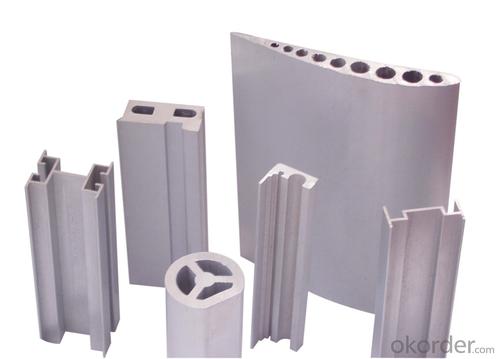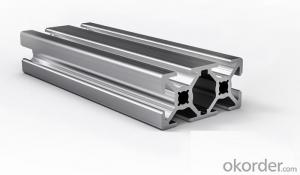Custom Powder Coated Aluminum Profiles - Hot Selling with Lower Price LED Aluminum Profile
OKorder Service Pledge
OKorder Financial Service
You Might Also Like
Aluminium is a relatively soft, durable, lightweight, ductileand malleablemetalwith appearance ranging from silvery to dull gray, depending on the surfaceroughness. It is nonmagnetic and does not easily ignite. A fresh film ofaluminium serves as a good reflector (approximately 92%) of visible lightand an excellent reflector (as much as 98%) of medium and far infraredradiation. The yield strength of pure aluminium is 7–11 MPa,while aluminium alloys have yield strengths ranging from200 MPa to 600 MPa. Aluminium has about one-third the densityand stiffness of steel. It is easily machined,cast, drawn and extruded.
Features:
Material | Alloy 6063,6061,6005or according to customer’s choice |
Temper | T3, T4, T5, T6 |
Surface | Anodize, electrophoresis, powder coating, PVDF coating, wood grain painting, matted, etc. |
Length | Coating 6.5 meters, Anodizing 6.5 meters, Mill finish 5 meters |
Application | Industrial, electrical equipment(TV set, air conditioner, refrigerator, computer), decoration,construction, transportation |
Custom Made | We can package following with customer's request. |






- Q: Are aluminum profiles suitable for modular construction?
- Aluminum profiles are an excellent choice for modular construction due to their many advantages. Not only are they lightweight, but they also possess considerable strength, making them perfect for supporting heavy loads in modular buildings. This structural integrity ensures the safety and stability of the entire structure. Additionally, aluminum profiles are resistant to corrosion, which is essential for modular construction projects that may face various weather conditions. This resistance enhances the durability and lifespan of the modular constructions, ultimately reducing maintenance costs in the long term. Moreover, aluminum is highly versatile and can be easily shaped and sized to meet specific design requirements. This adaptability allows architects and engineers to create innovative and functional modular structures tailored to each project's needs. Furthermore, the lightweight nature of aluminum profiles makes them easier to transport and handle during the construction process, compared to traditional building materials like steel. This lightness also helps reduce the overall weight of the modular constructions, resulting in cost savings for transportation and foundation requirements. Additionally, aluminum is a sustainable material, as it is entirely recyclable and requires less energy to produce compared to other materials. This environmentally friendly aspect aligns with the increasing demand for sustainable building practices, making aluminum profiles an ideal choice for modular construction projects. In conclusion, aluminum profiles offer numerous advantages that make them highly suitable for modular construction. Their strength, resistance to corrosion, versatility, lightweight nature, and sustainability all contribute to creating durable, customizable, and efficient modular structures.
- Q: What are the strategies to reduce the environmental footprint when utilizing aluminum profiles in construction projects?
- <p>To minimize the environmental impact of using aluminum profiles in construction, consider the following strategies: Use recycled aluminum whenever possible, as it requires significantly less energy to produce than new aluminum. Opt for energy-efficient manufacturing processes and choose suppliers with strong environmental credentials. Design for disassembly and recycling to facilitate the reuse of aluminum profiles at the end of their life. Implement sustainable construction practices that reduce waste and emissions. Finally, educate stakeholders about the importance of sustainable materials and encourage the adoption of eco-friendly practices throughout the construction process.</p>
- Q: What are the different packaging options for aluminum profiles?
- Aluminum profiles can be packaged in various ways to suit the specific needs and preferences of customers. Here are some common packaging options: 1. Bundling: Small profiles of the same length and shape can be bundled together using straps or bands. This option allows for easy handling and transportation. 2. Wooden crates: Larger or delicate profiles are often packed in wooden crates, which provide excellent protection during shipping. The crates can be customized to fit the profiles perfectly. 3. Cardboard tubes: Thin and lightweight profiles, such as those used in the packaging industry, can be packaged in cost-effective cardboard tubes. This option ensures lightweight transportation and storage with adequate protection. 4. Pallets: When dealing with a large volume of profiles, pallets are commonly used. The profiles are stacked and secured on the pallet using strapping or shrink wrap. Pallets allow for efficient handling using forklifts or pallet jacks. 5. Custom packaging: Customers with specific requirements can opt for custom packaging solutions. This may include foam inserts, plastic wraps, or personalized labeling. Custom packaging ensures proper protection and adherence to handling instructions. To summarize, the packaging options for aluminum profiles depend on factors such as size, fragility, and volume. Whether it's bundling, wooden crates, cardboard tubes, pallets, or custom packaging, each option offers its own benefits in terms of protection, handling, and transportation convenience.
- Q: Can aluminum profiles be used for electrical cabinets?
- Yes, aluminum profiles can be used for electrical cabinets. Aluminum is a lightweight yet strong material that offers excellent thermal conductivity and electrical resistance. It is commonly used in electrical cabinets due to its durability and ability to dissipate heat effectively. Aluminum profiles provide a sturdy framework for electrical cabinets, allowing for easy installation of electrical components and wiring. Additionally, aluminum profiles can be easily customized and adjusted to meet specific design requirements, making them an ideal choice for electrical cabinets.
- Q: What are the advantages of using aluminum profiles in transportation vehicles?
- Using aluminum profiles in transportation vehicles offers several benefits. To begin with, aluminum is lighter than other metals like steel. This results in reduced fuel consumption and increased energy efficiency, making it perfect for vehicles that require frequent movement and long distances. Moreover, the lightweight nature of aluminum improves maneuverability and handling, enhancing overall vehicle performance. Secondly, aluminum profiles provide excellent corrosion resistance. This is especially important for transportation vehicles that face harsh weather conditions and corrosive elements like salt and moisture. Aluminum's corrosion resistance ensures the vehicle's longevity and durability, reducing maintenance and repair costs. Additionally, aluminum profiles are highly recyclable. The recycling process for aluminum requires less energy compared to producing primary aluminum. This not only reduces greenhouse gas emissions but also contributes to the sustainability of the transportation industry. Aluminum's recyclability aligns with the growing focus on eco-friendly practices. Furthermore, aluminum profiles offer great design flexibility. They can be easily extruded into various shapes and sizes, allowing manufacturers to create customized components and structures for transportation vehicles. This flexibility optimizes space and weight distribution, resulting in improved efficiency and functionality. Lastly, aluminum profiles are non-toxic and non-magnetic. This is advantageous in transportation vehicles as it eliminates the risk of interference with sensitive electronic systems and equipment. Aluminum's non-toxic nature also makes it a safe choice for transporting food and other sensitive materials. In conclusion, there are numerous advantages to using aluminum profiles in transportation vehicles. Its lightweight, corrosion resistance, recyclability, design flexibility, and non-toxic properties make it an ideal material for enhancing fuel efficiency, durability, sustainability, and overall performance in the transportation industry.
- Q: the middle of the following is a groove structure, as if you can not bolt hole, then how to install the rail on it? What's the use of flat sealing strips and slip bars embedded inside? Is it necessary to mount the guide rail on the aluminum profile, you can choose more than 6060 of the profiles, the middle is flat structure, and then drill holes in the bolt connection rail Thanks
- Use the T nut (in the T groove) to fit the rail, the flat sealing strip, and the slip bar embedded in it for dust, waterproof, oil proof and so on.Guide (TTW): metal or other materials made of grooves or ridges, can withstand, fixed, and guide the movement of devices or equipment, and reduce its friction of a device.
- Q: Ask Master: at present domestic industry deep aluminum extrusion production line of domestic manufacturers are also many, but the price is still the production line and abroad have obvious difference, then foreign production lines in what ways do better? Thank you
- On the equipment, the extrusion line of Germany and Japan is more automatic, and the on-line quenching is the setting program for automatic operation.
- Q: Are aluminum profiles energy-efficient?
- Yes, aluminum profiles are considered to be energy-efficient. Aluminum is a highly conductive material, which means it can effectively transfer heat or cold. This property allows aluminum profiles to provide excellent thermal insulation, helping to minimize energy loss and maintain a consistent indoor temperature. Additionally, aluminum profiles can be designed with thermal breaks, which further enhance their energy efficiency by reducing heat transfer between the inside and outside of a building. These features make aluminum profiles a popular choice for windows, doors, and other building components, as they contribute to energy savings and reduce the overall carbon footprint of a structure.
- Q: What are the different types of protective coatings for aluminum profiles?
- There are several different types of protective coatings that can be applied to aluminum profiles. Some common options include anodizing, powder coating, and liquid paint. Anodizing involves creating a protective layer of oxide on the surface of the aluminum through an electrochemical process. Powder coating involves applying a dry powder to the surface of the aluminum and then curing it in an oven to create a durable and protective coating. Liquid paint can also be used to provide protection and can offer a wide range of color options. Other options include chrome plating, chemical conversion coatings, and thermal spray coatings, each with its own unique benefits and applications.
- Q: Can aluminum profiles be used in the production of automotive interiors?
- Indeed, the utilization of aluminum profiles is viable for the production of automotive interiors. Aluminum, being a lightweight and resilient material, offers a plethora of advantages in the realm of automotive applications. Its exceptional resistance to corrosion is particularly significant, as it enables endurance in the demanding conditions within vehicles. Aluminum profiles possess the capability to fashion various components found in automotive interiors, including but not limited to door panels, instrument panels, seat frames, and trim pieces. Moreover, the malleability and adaptability of aluminum profiles facilitate the fulfillment of specific design requirements, thereby granting flexibility in the realm of automotive interior design. The incorporation of aluminum profiles in automotive interiors contributes to a reduction in overall vehicle weight, thereby enhancing fuel efficiency and diminishing emissions.
Send your message to us
Custom Powder Coated Aluminum Profiles - Hot Selling with Lower Price LED Aluminum Profile
OKorder Service Pledge
OKorder Financial Service
Similar products
Hot products
Hot Searches
Related keywords




























